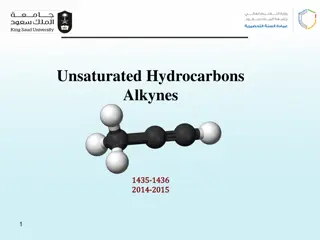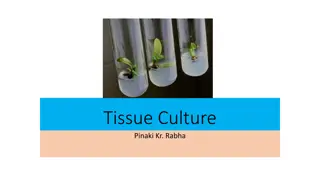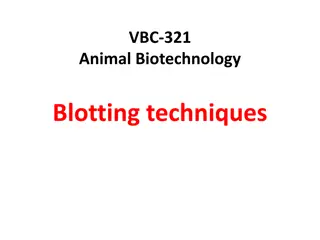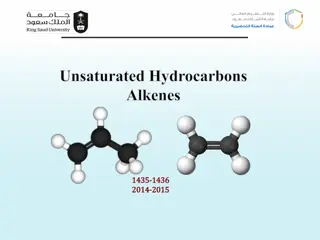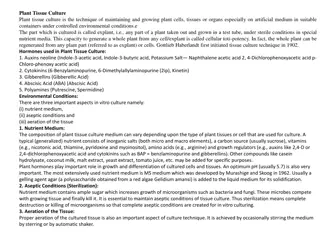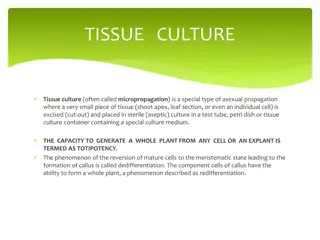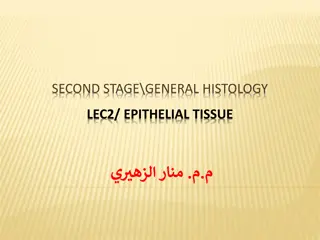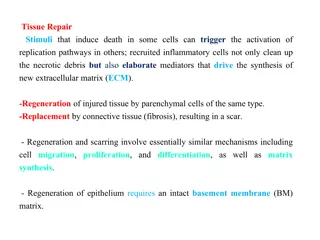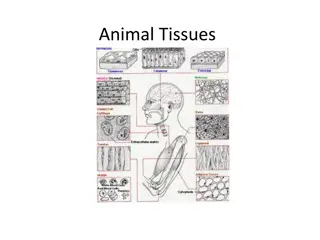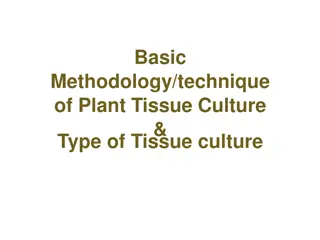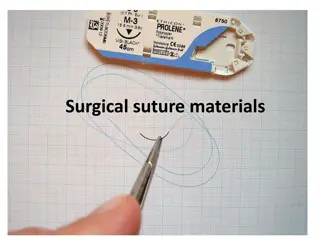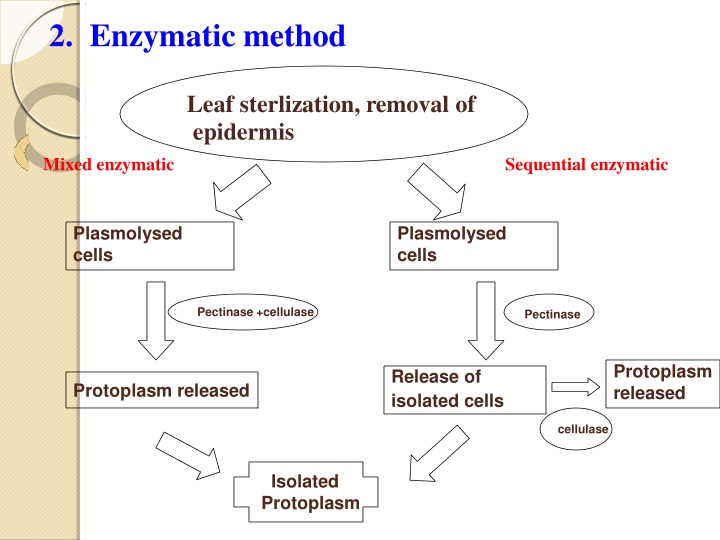
Protoplast Fusion and Culture Methods in Plant Biotechnology
Explore the enzymatic methods for leaf sterilization, epidermis removal, and isolation of plasmolysed cells using enzymes like pectinase and cellulase. Learn about the advantages of isolating protoplasts from leaves and pollen, and the process of protoplast culture involving somatic protection, cell division, and plant regeneration. Discover the applications of protoplast culture in developing novel hybrid plants, mutant isolation, genetic transformation, and more. Unveil the technique of protoplast fusion for combining desirable plant traits and creating mutinucleate protoplasm.
Download Presentation

Please find below an Image/Link to download the presentation.
The content on the website is provided AS IS for your information and personal use only. It may not be sold, licensed, or shared on other websites without obtaining consent from the author. If you encounter any issues during the download, it is possible that the publisher has removed the file from their server.
You are allowed to download the files provided on this website for personal or commercial use, subject to the condition that they are used lawfully. All files are the property of their respective owners.
The content on the website is provided AS IS for your information and personal use only. It may not be sold, licensed, or shared on other websites without obtaining consent from the author.
E N D
Presentation Transcript
2. Enzymatic method Leaf sterlization, epidermis removal of Mixed enzymatic Sequential enzymatic Plasmolysed cells Plasmolysed cells Pectinase +cellulase Pectinase Protoplasm released Release of Protoplasm released isolated cells cellulase Isolated Protoplasm
ISOLATION OF PROTOPLASTS in brief Isolation, mainly from leaves & pollen Mechanical Enzymatic Generally used Advantages: 1. Large quantity of protoplasts obtained 2. Cells not broken 3. Osmotic shrinkage is much less Used occasionally Advantage: Unknown effects of enzymes on protoplast eliminated Disadvantage: Disadvantage: Unknown effects of enzymes on protoplast Cells may be broken 64
PROTOPLAST CULTURE Isolated protoplast are usually cultured in either liquid or semisolid agar media plates. They require somatic protection in culture medium until they generate strong cell wall. Methodology of Protoplast culture is described below: a Isolated Protoplast is cleaned by centrifugation and decantation method The protoplast solution (1 105 protoplast/ml) is poured on sterile and cooled molten nutrient medium Mix the two gently but quickly by rotating each petridish Allow the medium to set, seal petridishes with paraffin film and incubate Protoplasts capable of dividing undergo cell divisions from callus within 2-3 weeks The callus is then subculture on fresh medium Embryogenesis begin from callus when it is transferred to a proper nutrient medium and subsequently whole plant develops 65
Applications of protoplast culture To develop Novel hybrid plant through protoplast fusion. 1. 2. In single cell derived colony, isolation of mutants through mutagens is easier. 3. Single cell cloning can be easily performed with protoplasts. 4. Regeneration of entire plant or plant improvement through protoplast culture. 5. Genetic transformation through DNA uptake can be achieved. 6. Reproducible protoplast to plant systems are now available for many plants of agronomic value. 66
Protoplast fusion Protoplast fusion It is the technique in which two or more protoplast are fused into a single cell protoplast. The protoplast fusion allows us to bring an desirable plant traits in combination that are not possible by sexual means. May occur between same or different plant Mutinucleateprotoplasm obtained after fusion 67
Three main phases are there for fusion: 1. Agglutination: Plasma membrane of two or more protoplast are brought into close proximity. (Aand B) 2. Membranes of protoplasts agglutinated by fusogen get fused at the point of adhesion. This results in formation protoplast. the the of cytoplasmic bridge between 3. Rounding expansion hetrokaryon Binulceate results in a tetraploid hybrid cell. Also cybrid cell is formed with a selective chromosome loss. off of the fused protoplast due to the of cytoplasmic bridge froming a spherical (A-B) or homo karyons (A-A or B-B). hetero karyons. The fusion of the nuclei 68
Stages of Protoplast fusion and Hybridization Protoplast A Protoplast B A+B 2A 2B A-A Homokaryon B-B Homokaryon A-B Hetrokaryon Cybrid A-B Hybrid (Cytoplasmic hybrid ) 69
Methods of Protoplast fusion Techniques/Methods of Protoplast Fusion (Fusion of protoplasts of two different genomes) 1. Spontaneous Fusion 2. Induced Fusion Intraspecific Intergeneric Chemical Mechanical Electrical
Techniques/Methods of Protoplast Fusion Spontaneous Fusion Protoplast fuse spontaneously during isolation process mainly physical contact among similar parental protoplast. Protoplast from their adjoining plasmodesmata to form a multinucleate protoplast. Two types of spontaneous fusion Intraspecific produce homokaryones Intergeneric have no importance Induced Fusion Freely isolated protoplast from different sources are help of fusion inducing agents. Fusion needs an inducing agent that actually reduces electro negativity and allows the isolated protoplast to fuse. The various fusogens used for induced fusion are various class as below: c) Electrical fusion due to cells fuse through their fused with the classified under a) Chemical fusion b) Mechanical fusion
a) Chemical Fusion Types of Polyvinyl negative agents when cell membrane are brought into close physical contact they fuse. Mechanical Fusion It is not dependent upon the presence of fusion inducing agent. Physical fusion of protoplasts is done under microscope micropipette. c) Electrical Fusion Protoplast are placed into a small culture cell containing electrodes and a potential difference (10kv then the protoplast will line up (form chain) between the electrodes. Fusion of protoplasts of chain is induced by application of high strength electric field (100kv fusogens are used like PEG, NaNo3, alcohol (PVA) etc. The cell membrane posses charge and after treatment with such chemical Ca2+ ions, b) by using micromanipulator and perfusion m-1) is applied the for m-1)
Somatic hybridization Defination: The technique of hybrid production through the fusion of isolated somatic protoplast under in-vitro conditions and subsequent development of their product to a hybrid plant is called somatic hybridization. 73
Various stages of somatic hybridization are as follows 1. Isolation of protoplast 2. Fusion of the protoplasts of desired species/varieties 3. Identification and Selection of somatic hybrid cells 4. Culture of the hybrid cells 5. Regeneration of hybrid plants
1. Isolation of Protoplast Same as discussed before Fusion of isolated Protoplast Same as discussed before Identification and Selection of somatic hybrid cells 3. The protoplasts of two parents may be labelled by different fluorescent compounds, which will then enable for the identification and selection of hybrids. Identification is based on difference between the parental cells and hybrid cell with respect to Pigmentation, Cytoplasmic markers, Presence of chloroplast, Nuclear staining etc. In the mixture of both fused and unfused protoplast Selection of hybrid is done on the basis of several procedures like Genetic complementation, antibiotec-resistant cell lines, isoenzyme analysis, Phytotoxins, Specific amino acid, Auxin Auxotrophic and metabolic mutants, Chromosomal hybird cell, Herbicides etc. 2. autotrophy, analysis by 75
4. Culture of the hybrid cells Hybrid cells are cultured on suitable medium provided with the appropriate culture conditions. 5. Regeneration of hybrid plants Plants are induced to regenerate from hybrid cells.These hybrid plants must be at least partially fertile, in addition to having some schemes. useful property, to be of any use in breeding 76
Advantages of somatic hybridization Novel approach for introducing or variability at nuclear or extra nuclear organelle genome level, in higher plants Production of novel interspecific and intergenic hybrid e.g. Pomato (Hybrid of potato and tomato) Somatic hybridization is significant in improvement of plants such as banana, potato, sugarcane, and yam. Production of fertile diploids and polypoids from sexually sterile haploids, triploids and aneuploids Transfer gene for disease resistance, abiotic stress resistance, herbicide resistance and many other quality characters. Production of heterozygous lines in the single species which cannot be propagated by vegetative means Studies on the fate of plasma genes Production of unique hybrids of nucleus and cytoplasm increasing genetic
Limitations of Somatic hybridization Poor regeneration of hybrid plants Non-viability of fused products Not successful in all plants. Production of unfavorable hybrids Lack of an efficient method for selection of hybrids No confirmation of expression of particular trait in somatic hybrids. Elimination of chromosomes from the hybrid cell
PROTOPLAST FUSION FROM 2 DIFFERENT PLANT SPECIES & LATER PLATING & SELECTION OF HYBRID COLONIES & REGENERATION OF SOMATIC HYBRID PARENT PLANT A PARENT PLANT B TREATMENT WITH FUSION CHEMICAL ISOLATED PROTOPLASTS B ISOLATED PROTOPLASTS A AGGREGATION PROTOPLAST FUSION 79
PLATING OF FUSED PROTOPLAST SELECTION OF HYBRID COLONIES TRANSFER OF CALLUS TO DIFFERENTIATION MEDIUM SELECTION OF SOMATIC HYBRID PLANTS 80

